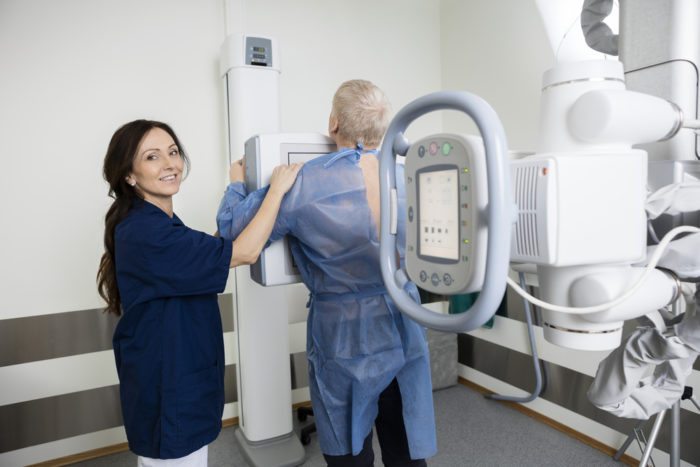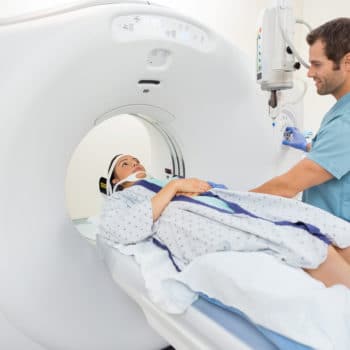Why We Love It
-
$45,730Potential Avg. Salary
-
23.2%Job Growth Rate
-
Growing DemandJob Outlook
-
Dependable Daily WorkloadCareer Attribute
Also commonly referred to as radiologic technologists or radiographers, x-ray technicians specialize in using imaging equipment to capture images that are used in medical diagnosis. They use their skills to capture images that are used to diagnose broken bones, cavities, breast cancer, and other health issues.
Recommended Schools
What is a X Ray Technician?
The following job responsibilities are common for individuals in x-ray technician roles:
- Ask patients a series of questions before performing x-rays to determine if imaging would present any issues or risks
- Prepare patients for x-rays by shielding certain areas of the body or positioning patients
- Use x-ray imaging systems and computed tomography (CT) equipment to capture images
- Follow instructions from physicians to capture the exact areas needed for diagnosis
- Present images to ordering physicians to determine if images captured are viable for diagnosis
A Day in the Life
X-ray technicians work in a variety of healthcare settings and use their skills to capture images of tissues and bones that physicians can use to diagnose health problems. They use computerized equipment like x-rays and computed tomography (CT) scanners to produce images that can diagnose issues like broken bones, cavities, and cancer. They may work in dentist offices, hospitals, urgent care centers, doctors’ offices, or any setting where x-rays could be helpful in diagnosing patient issues and needs.
When a patient arrives for an x-ray, the technologist first asks a series of questions designed to determine if any issues or risks exist that should prevent x-rays from being taken. If all questions have satisfactory answers, the technologist prepares the patient for the exam. He/she shields areas of the body that do not need to be imaged from radiologic exposure, inserts any equipment needed for positioning, and positions the patient in a way that allows quality images to be captured.
Next, the x-ray technologist refers to instructions from the ordering physician to capture all images necessary for diagnosis. The technician reviews captured images to ensure quality, and then presents the images to the ordering physician. If additional images are needed for diagnosis, the technician may need to work to capture additional images so patients can be properly diagnosed. The technologist finishes his/her work by updating patient records and filing the images taken into medical records.
Typical Work Schedule
Most x-ray technicians work full-time schedules, but thy may be required to work irregular hours. Those that work in doctors’ or dentists’ offices may work more traditional business hours, but those who work in hospitals or urgent care centers may be required to work evening, weekend, or even overnight shifts.
Projected Job Growth
Demand for x-ray technicians is expected to grow in the coming decade as the large, aging Baby Boomer generation will increase demand for medical care. As individuals age, they have an increased risk for issues like cancer and osteoporosis that can be diagnosed using x-ray technology, so the increased number of seniors in the coming decades is expected to increase demand for qualified x-ray techs.
Typical Employers
More than half of all x-ray technicians are employed to work for both public and private hospitals. Others work in doctors’ offices, dentists’ offices, diagnostic laboratories, and urgent care centers.
Recommended Schools
How To Become a X Ray Technician
The first step in becoming an x-ray technician is to earn a degree from an accredited program. The types of degrees available range from certificate to bachelor’s degree, but the most common degree earned by aspiring x-ray technicians is an associate’s degree in radiologic technology. Most states require x-ray technicians to be licensed to work in the field, and many of the states that require licensure require completed degrees to be earned from programs accredited by the Joint Review Committee on Education in Radiologic Technology.
However, all states have different requirements for licensing x-ray technicians, so it’s important to review the requirements for your state of practice before beginning your educational journey. In general, becoming licensed requires completing an associate’s degree and passing a certification exam. With the proper education and license, you should be able to find entry-level work in the field as an x-ray technician. With experience, you can move up the ladder into higher-paying positions.
After working as an x-ray technician for several years, you may qualify to move into a specialty in the field. Some x-ray technicians become MRI technicians or mammographers later in their careers. In some cases, moving into these roles will require additional education and state licensure, and in other cases, going through on-the-job training is sufficient for securing work in an x-ray tech specialization.
X Ray Technician Salary Data
We’ve provided you the following to learn more about this career. The salary and growth data on this page comes from recently published Bureau of Labor Statistics data while the recommendations and editorial content are based on our research.
National Anual Salary
Low Range
$32,030Average
$45,730High Range
$70,340National Hourly Wage
Low Range
$15/hrAverage
$22/hrHigh Range
$34/hrHow do X Ray Technician salaries stack up to other jobs across the country? Based on the latest jobs data nationwide, X Ray Technician's can make an average annual salary of $45,730, or $22 per hour. This makes it an Above Average Salary. On the lower end, they can make $32,030 or $15 per hour, perhaps when just starting out or based on the state you live in.
Salary Rankings And Facts
#443 Nationally for All Careers
Programs and Degrees
Here are the most common degrees for becoming a X Ray Technician. a is usually recommended and specifically a degree or coursework that prepares you for the particular field, see below.
Highest Education Among X Ray Technicians
- 4.8% Doctorate
- 7.5% Masters
- 21.3% Bachelors
- 14.4% Associates
- 31% College
- 19.3% High School
- 1.7% Less than High School
Job Growth Projections and Forecast
2014 Total Jobs
102,2002024 Est. Jobs
125,900Job Growth Rate
23.2%Est. New Jobs
23,700How does X Ray Technician job growth stack up to other jobs across the country? By 2024, there will be a change of 23,700 jobs for a total of 125,900 people employed in the career nationwide. This is a 23.2% change in growth over the next ten years, giving the career a growth rate nationwide of Below Average.
Growth Rankings And Facts
#36 Nationally for All Careers
What Companies Employ The Most X Ray Technicians
| Industry | Current Jobs | New Jobs Needed | % Increase |
|---|---|---|---|
| General medical and surgical hospitals; private | 39,200 | 2,800 | 3% |
| Offices of physicians | 9,500 | 2,100 | 2% |
| General medical and surgical hospitals; local | 4,500 | -100 | 0% |














